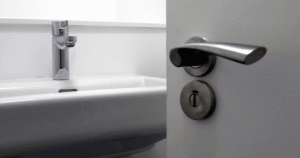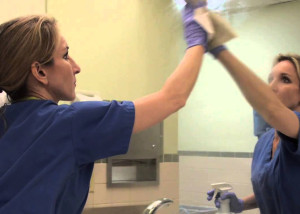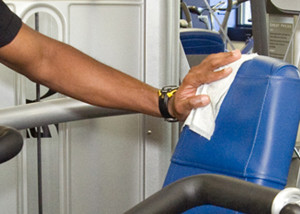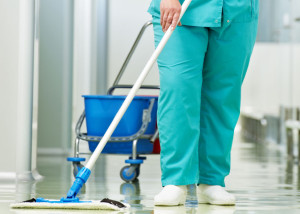When to disinfect? When to sanitize?
 One of the common points of confusion in the commercial cleaning industry is the delineation between the terms Sanitizer and Disinfectant. Too often the terms are used interchangeably, when in fact there are clear differences between the two terms and the processes they represent.
One of the common points of confusion in the commercial cleaning industry is the delineation between the terms Sanitizer and Disinfectant. Too often the terms are used interchangeably, when in fact there are clear differences between the two terms and the processes they represent.
It is crucial that custodial staffs understand which process is appropriate at the right time, in the right environment, and with the appropriate methods and products. All involved in the cleaning and maintenance of facilities need to be aware of what defines a disinfectant, what defines a sanitizer, and what situations call for each type of product. Supervisors should have a sound understanding of how these products are classified and how they are regulated. Through this knowledge, supervisors and staff members will all be aware of when it is appropriate to sanitize and when it is appropriate to disinfect.
The Environmental Protection Agency (EPA) regulates products that make claims to killing organisms. This regulation is authorized by the Federal Insecticide, Fungicide and Rodenticide Act (FIFRA). Under FIFRA there are specific requirements on label information, use-dilution, formula, and manner of application.
CLEANING
 Cleaning is the basic task upon which the Jan-San Industry is based. Cleaning removes visible debris, dirt, soils, and dust. This is accomplished, typically with soap or detergent and water, by scrubbing, washing, and rinsing. Also removed during cleaning are allergens and microorganisms. However, while the allergens and microorganisms are removed from a surface, they are not killed simply by cleaning. Instead there is the possibility they may be transferred from one surface to another. The conveyance of this cross contamination is typically the cleaning tool being used, such as a mop, sponge, or cloth.
Cleaning is the basic task upon which the Jan-San Industry is based. Cleaning removes visible debris, dirt, soils, and dust. This is accomplished, typically with soap or detergent and water, by scrubbing, washing, and rinsing. Also removed during cleaning are allergens and microorganisms. However, while the allergens and microorganisms are removed from a surface, they are not killed simply by cleaning. Instead there is the possibility they may be transferred from one surface to another. The conveyance of this cross contamination is typically the cleaning tool being used, such as a mop, sponge, or cloth.
SANITIZING
 Sanitizing is the act of making a surface sanitary and free of microorganisms that could negatively impact one’s health, by killing 99.9% of microorganisms. Sanitizers reduce the amount of microorganisms on a surface to a level considered safe as determined by public health codes and/or public health regulations. Sanitizers accomplish this with minimal dwell times on the surfaces. It is not recommended or required to rinse food contact surfaces with potable water after the use of a sanitizer.
Sanitizing is the act of making a surface sanitary and free of microorganisms that could negatively impact one’s health, by killing 99.9% of microorganisms. Sanitizers reduce the amount of microorganisms on a surface to a level considered safe as determined by public health codes and/or public health regulations. Sanitizers accomplish this with minimal dwell times on the surfaces. It is not recommended or required to rinse food contact surfaces with potable water after the use of a sanitizer.
DISINFECTING
 Disinfecting goes a level beyond sanitizing. Disinfectants destroy, kill, or inactivate 99.999% of germs on hard, non-porous, inanimate surfaces and objects. These products are used in various facilities to destroy or irreversibly inactive bacteria, viruses, and fungi. Certain disinfectants can also control the growth of mold and mildew.
Disinfecting goes a level beyond sanitizing. Disinfectants destroy, kill, or inactivate 99.999% of germs on hard, non-porous, inanimate surfaces and objects. These products are used in various facilities to destroy or irreversibly inactive bacteria, viruses, and fungi. Certain disinfectants can also control the growth of mold and mildew.
DIFFERENCES BETWEEN SANITIZING AND DISINFECTING
While on the surface it appears that sanitizers and disinfectants are similar, there are vast differences between the two processes and types of products.
- Sanitizers reduce microorganisms to 99.9%, while disinfectants reduce microorganisms to 99.999%. The disinfectant solutions are 100 times more effective than sanitizer solutions.
- Quaternary sanitizers have an activity level of 200 to 400 parts per million (PPM), while a product is required to have a minimum activation level of 400 PPM to be classified as a quaternary disinfectant. (Disinfectants will vary in terms of minimum PPM for effectiveness, refer to individual disinfectant labels for exact dilution requirements).
- Disinfectants typically kill a wider range of organisms than sanitizers, but usually require more contact time on surfaces.
- Sanitizers generally require less contact time on surfaces than disinfectants.
- Sanitizers are less active concentrations, which reduces residue left behind on a surface.
- Disinfectants leave behind more quaternary residues than sanitizers. Some disinfectants have added fragrances, which may also be left on the surface. Unlike when using a sanitizer, when using a disinfectant on a food contact surface, it is typically recommended to wipe with a clean cloth or allowed to air dry.
- Some disinfectants are “One Step” Disinfectant Cleaners, formulated with surfactants or detergents to aid in the cleaning process. These products eliminate the need to pre-clean surfaces prior to disinfection, except in cases of heavily soiled surfaces.

WHERE TO SANITIZE?
While sanitizers are not as active as disinfectants, there are advantages to using these products over disinfectants in certain environments and in certain situations.
Sanitizers are typically associated with the food service industry since the reside left behind on food contact surfaces is low enough to meet levels considered safe by public health codes and public health regulations. Sanitizers also require shorter dwell times than disinfectants on surfaces. In fast moving, food service environments, the longer dwell times required by disinfectants are not practical. For instance, in a busy restaurant, management cannot afford to let a table sit unoccupied during the longer dwell time required for a disinfectant, but the shorter amount of downtime while the sanitizer dwells is feasible.
While the short dwell times and ability to reduce germs and bacteria to safe levels make sanitizers ideal for food service facilities, they are also an optimal choice for other areas which contain food contact surfaces, such as employee breakrooms along with cafeterias in educational and medical facilities. Prime examples of areas best served by sanitizers include:
- Day Care Centers
- Desks
- Tables
- Toys
- High Chair Trays
- Schools
- Desks
- Cafeteria Tables
- Door Knobs
- Employee Break Room Surfaces
- Counters
- Tables and Chairs
- Appliance Control Knobs and Handles
- Commercial Kitchen Surfaces
- Cutting Boards
- Dishes
- Utensils
- Other Food Prep and Kitchen Areas
- Barware
- Restaurant Front-Of-House Surfaces
- Table Tops
- Bars
- Chairs / Bar Stools
- Server Stations
- Healthclub / Gym / Fitness Center Exercise Equipment
For more information regarding NCL Sanitizers, please click here.

WHERE TO DISINFECT?
Disinfectants are typically associated with medical environments. First and foremost, medical facility surfaces require disinfection on a non-stop basis. However, despite the obvious association between disinfection and medical facilities, there are multiple other areas where merely cleaning or even sanitizing is not enough and disinfection is recommended.
At the top of the list are restrooms. All non-porous restroom surfaces should be disinfected on a regular basis to ensure the health and well-being of all who use these facilities. The floors should be frequently mopped with a neutral disinfectant floor cleaner. Disinfectant bowl cleaners should be used in toilet bowls and in urinals. Other surfaces which are to be disinfected via a spray and wipe method include:
- Sinks and countertops
- Partition walls and doors
- Safety handles
- Fixtures

In facilities such as health clubs and schools, where locker rooms are present, they should be maintained similarly to restrooms. The surfaces found in these areas, especially the showers should be regularly disinfected.
In all other non-medical facilities, it is recommended to have high-touch surfaces disinfected frequently. While cleaning the majority of surfaces in non-medical facilities is normally sufficient, high touch areas require the further step of disinfection. Disinfecting surfaces kills bacteria and viruses, helping to stop the spread of disease and illness through a facility. Examples of high touch areas to be disinfected frequently in non-medical facilities include:
- Light switches
- Computer keyboards
- Telephones
- Remote Controls
- Thermostats
- Soap and paper towel dispensers
- Trash receptacles
- Door handles / doorknobs
- Door handles / Doorknobs
- Railings
- Cabinet handles / knobs
- Elevator button panels

For more information regarding NCL’s line of quaternary, bowl & bathroom, ready-to-use, and aerosol disinfectants, please click here.
 English
English Español
Español
